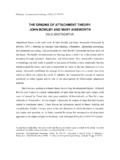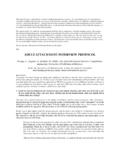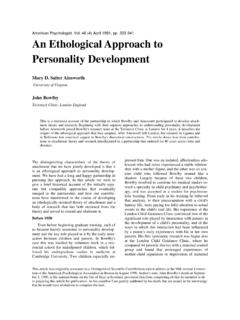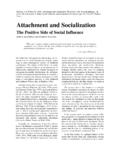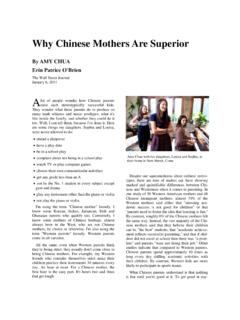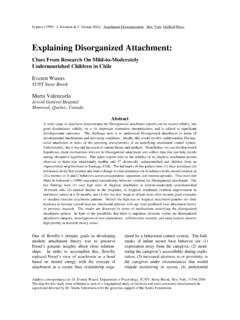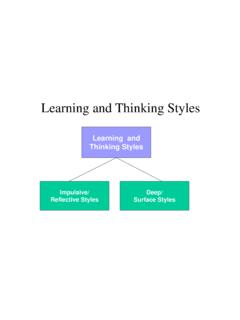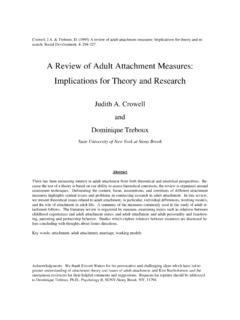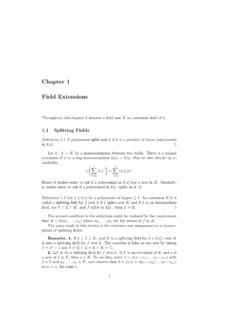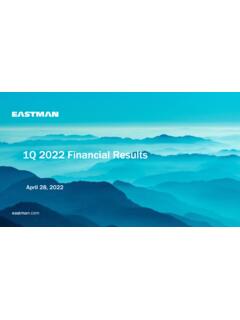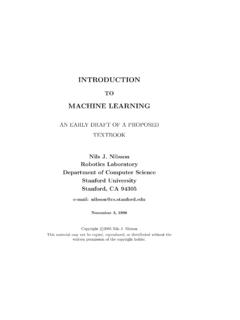Transcription of The Q-Sort Method in Personality Assessment and …
1 The Q-Sort Method in Personality Assessment and Psychiatric Research Jack Block, Department of Psychology University of California Berkeley, California Charles C Thomas Publisher Springfield Illinois USA. AMERICAN LECTURE SERIES(c). A Monograph in The BANNERSTONE DIVISION of AMERICAN LECTURES IN PSYCHOLOGY. Edited by MOLLY HARROWER, Professor of Research in Clinical Psychology Department of Psychiatry Temple University School of Medicine Philadelphia, Pennsylvania Block Q-Sort Method CHARLES C THOMAS PUBLISHER. Bannerstone House 301-327 East Lawrence Avenue, Springfield, Illinois, This book is protected by copyright. Into part of it may be reproduced in any manner with-out written permission from the publisher. 1961, by CHARLES C THOMAS PUBLISHER. Library of Congress Catalog Card Number: 61-10370. With THOMAS BOOKS careful attention is given to all details of manufacturing and design. It is the Publisher's desire to present books that are satisfactory as to their physical qualities and artistic possibilities and appropriate- for their particular use.
2 THOMAS. Books will be true to those laws of quality that assure a good name and good will. A philosopher must be very honest to avail himself of no aid from. poetry or rhetoric . SCHOPENHAUER. Printed in the United States of America 2. Block Q-Sort Method ACKNOWLEDGMENTS. The reader of this monograph will recognize, rather soon and then repeatedly, that its contents have been influenced in fundamental ways by the work of William Stephenson, the splendid protagonist of Q-technique. This is an inevitable indebtedness for all matters of Q-methodology have been touched by Stephenson's writings. I would like to respect- fully acknowledge here the decisive impact Stephenson has had upon my own thinking. Any work, and this one perhaps more than most, has untraceable links to colleagues and to friends. In various places in the text, I have tried to record my gratitude to indi- viduals who have helped this effort along its way.
3 Because so many persons have been involved at one time or another, I doubtless have failed to remember a number of names which properly should have been included. For this I am sorry. I have better memory for the help I have received most recently. An earlier version of the present manuscript was read critically by a number of people and the present revision is, I believe, much the better for having run this friendly gauntlet. Various elliptical, tan- gential, and circular arguments have been excised or brought closer to earth and I have been enabled to correct certain errors before the embarrassment of seeing them in print. I. have not accepted all of the suggestions these readers have offered for on certain partisan issues, I have chosen to express my own standpoint. I have been made aware, however, and I trust the manuscript now reflects this recognition, of the diversity of viewpoints that may be justified in regard to the issues treated here.
4 Of course, for such errors as still remain, I alone am responsible. For their incisive and yet not ego-wounding help, I am much indebted to Jeanne H. Block, Lee J. Cronbach, Harrison G. Gough, Robert E. Har- ris, Robert R. Holt, Jean Walker Macfarlane, Norman Livson and Paul H. Mussen. This work was supported in part by research grant M-1078 from The National Institute of Mental Health, of the National Institutes of Health, Public Health Service. The aid af- forded by this grant along with the congenial surroundings of the Institute of Personality Assessment and Research under its director, Donald W. MacKinnon, helped immensely in seeing this book through. I should like, too, to record my debt to Anne Lipow and to Charlotte Mendez who have made fit for a reader a manuscript messy and patched be- yond belief. In her other, non-professional role, I am grateful, deeply, to my wife, Jeanne, for her faith and her encouragement during this enterprise.
5 She defended me from the children for the hours I required and supported me during my vacuums of unproductivity. JACK BLOCK. 3. Block Q-Sort Method CONTENTS. Chapter I. An Introduction to the Q-Sort Method of Personality Description 5. II. A Perspective on Observer-Evaluations of Personality 24. III. Stephenson's Orientations Toward Q-set Construction 39. IV. Constructing the California Q-set 42. V. Evaluation of the CQ-items 49. VI. The Methodology of Q-sorting 56. VII. Research Applications of the CQ-set 69. VIII. Concluding Remarks 88. References 94. Footnotes 101. In order to reduce file size, the following Appendices are omitted A. The California Q-set (Form III) - B. Instructions for Using the California Q-set - C. A Comparison of the Results Provided by Different Q-sets - D. A CQ-set Description of the Optimally Adjusted Personality , as Viewed by Clinical Psychologists - E. A CQ-set Description of the Male Paranoid, as Viewed by Clinical Psychologists - F.
6 A CQ-set Description of the Female Hysteric, as Viewed by Clinical Psychologists - G. Table for Converting Sum d -, into r - H. An Adjective Q-set for Use by Non-Professional Sorters (Form III) - Index - 4. Block Q-Sort Method Chapter I. AN INTRODUCTION TO THE Q-Sort Method OF Personality DE- SCRIPTION. In this monograph a language instrument is presented which aims to permit the com- prehensive description, in contemporary psychodynamic terms, of an individual's person- ality in a form suitable for quantitative comparison and analysis. The language instru- ment consists simply of a set of Personality variables-the California Q-set-together with instructions for ordering these variables so as to describe a designated person. The proce- dure proposed is a specific application of the rather general scaling technique due to Ste- phenson and known as the Q-Sort Method (Stephenson, 1953). A device with the desired properties, once achieved, should have wide applicability in both research and teaching settings.
7 In the last half-generation or so, there has been in- creased emphasis on an understanding of Personality functioning and a disappointment in the rate of increase of knowledge in this area. Most disconcertingly, people are asking what, if anything, we know or can agree to in this field. Is there a typical mother of schizophrenics, for example? In all the talk about the "creative Personality " or the "authoritarian Personality ," just what have people meant by these terms? What do psy- chiatrists and clinical psychologists intend by the notion of "ego strength"? What really is "hysteria"? A person dominated by a strong "need achievement" has what kind of quali- ties? A short journey to the literature will indicate quickly and emphatically that questions such as these are properly to be asked if the haze of ambiguity is to be lifted. Effective communication among scientific peers is no guarantee of advance in the science but it remains a pre-condition.
8 This premise for progress very frequently fails to obtain. The primary virtue of the presently offered technique is that it provides a convenient means of objectifying the impressions and Personality formulations of observers. By so doing, of course, the extent of agreement among people in the way in which concepts are employed can be assessed. The more important con-sequence, however, of this means of encoding Personality evaluations is that a most rich but most complicated informational resource can come into versatile and fruitful research use in psychiatry and psychology. Currently, Personality evaluations by professionally-trained observers are in disrepute as unreliable, invalid expressions of capriciously held notions of Personality . There are a number of reasons, some of them valid, why this critical attitude so dominates the psy- chological scene. A fundamental purpose of the present monograph is to speak out for 5.
9 Block Q-Sort Method the usefulness and even the inevitability of observer-evaluations as a research Method . Criticisms of observer-evaluations are discussed and some ways of meeting these con- cerns are proposed. By way of support for our point of view, a variety of research appli- cations of the Method and principles here advocated are described. CAUTIONARY REMARKS. It is important that the reader recognize quite clearly the special intention of the lan- guage technique-the CQ-procedure -we shall be describing. We are concerned with a Method for portraying in a comprehensive and articulated fashion the Personality evalua- tion a professionally-trained, competent observer forms of a subject or patient. This for- mulation is expressed by means of a carefully devised standard language in order to as- sure the possibility of comparison from observer to observer. The variables of Personality of which the standard language is composed come from no one theoretical conceptualization.
10 The sad, existential truth of our situation is that no systematic, exhaustive and fully acceptable theory of Personality exists; there is no even semi-formal system of behavior which includes the complete array of Personality attrib- utes psychologists have come to believe it is important to consider. If it did, the neces- sary and sufficient set of variables to portray Personality functioning would be known and no problem of choice would arise. In our imperfect situation, however, some reasonable criterion for constituting an inelastic vocabulary had to be found. The solution adopted attempts, as we shall see later, to respect current in-formed opinions as to what aspects of Personality functioning have consequence. The result is that the language developed has links to a variety of theoretical orientations; it en- joys many of the insights (but also many of the deficiencies) of contemporary clini- cal views and in content is reasonably familiar to workers in Personality , clinical psychology and psychiatry.
